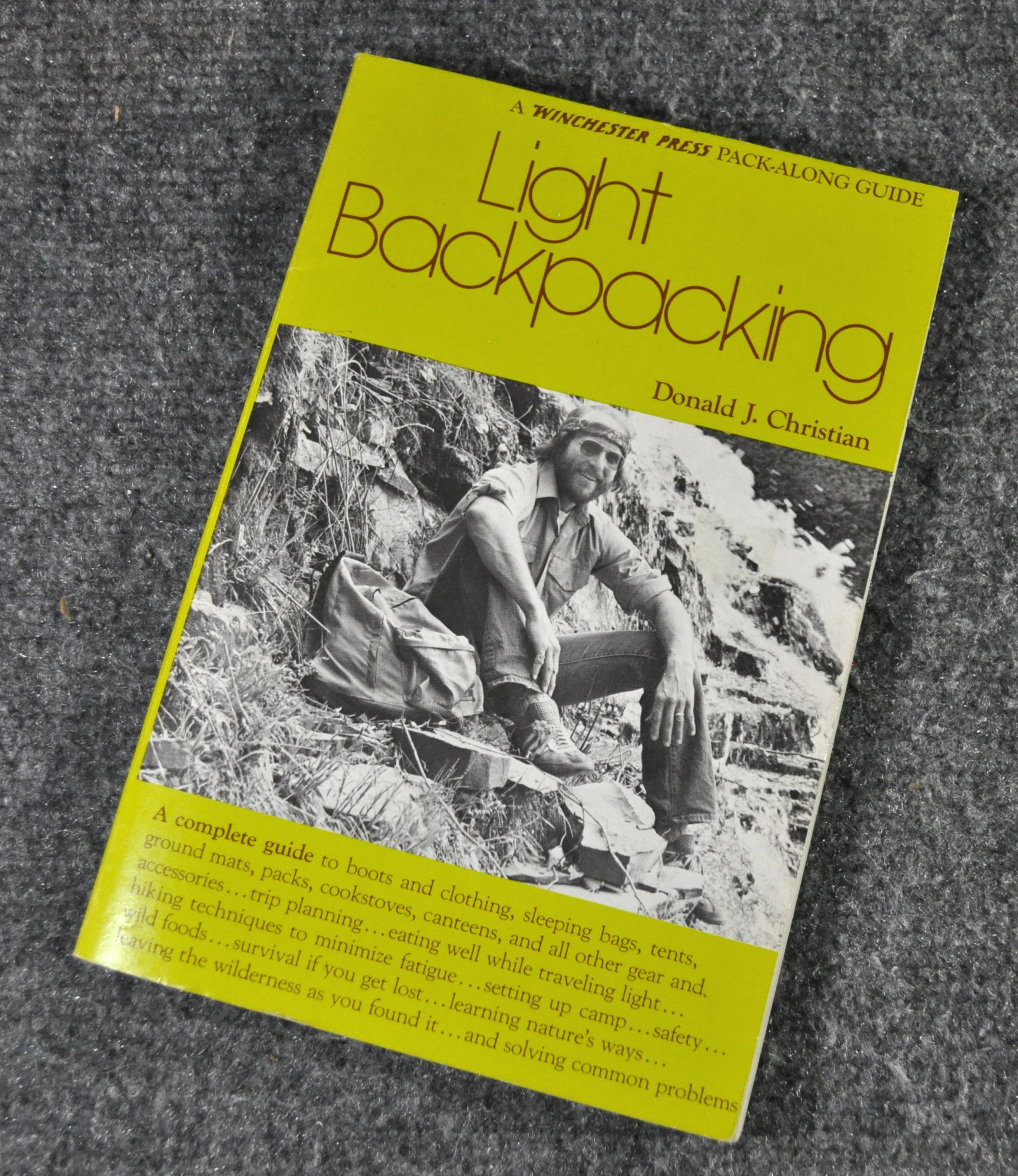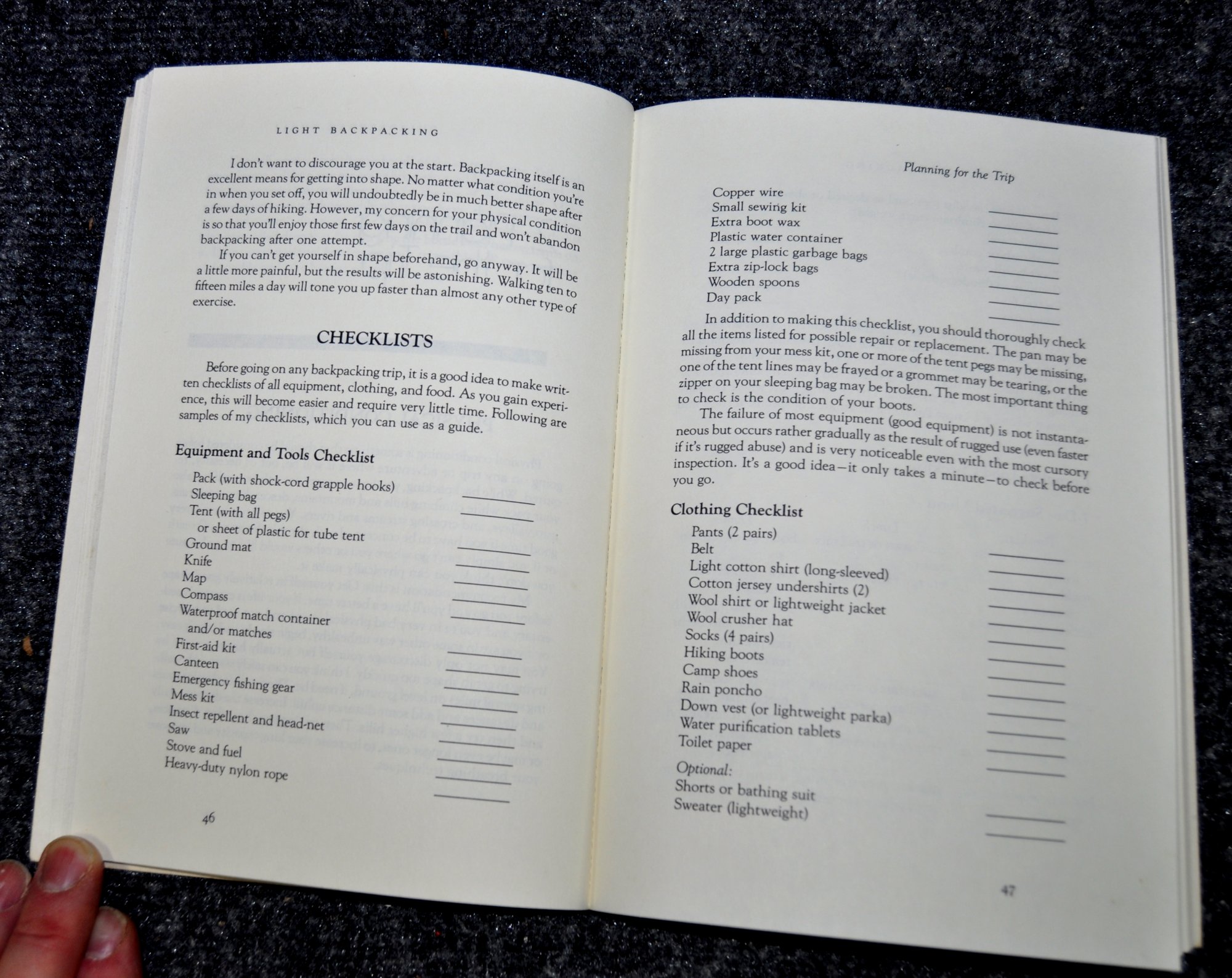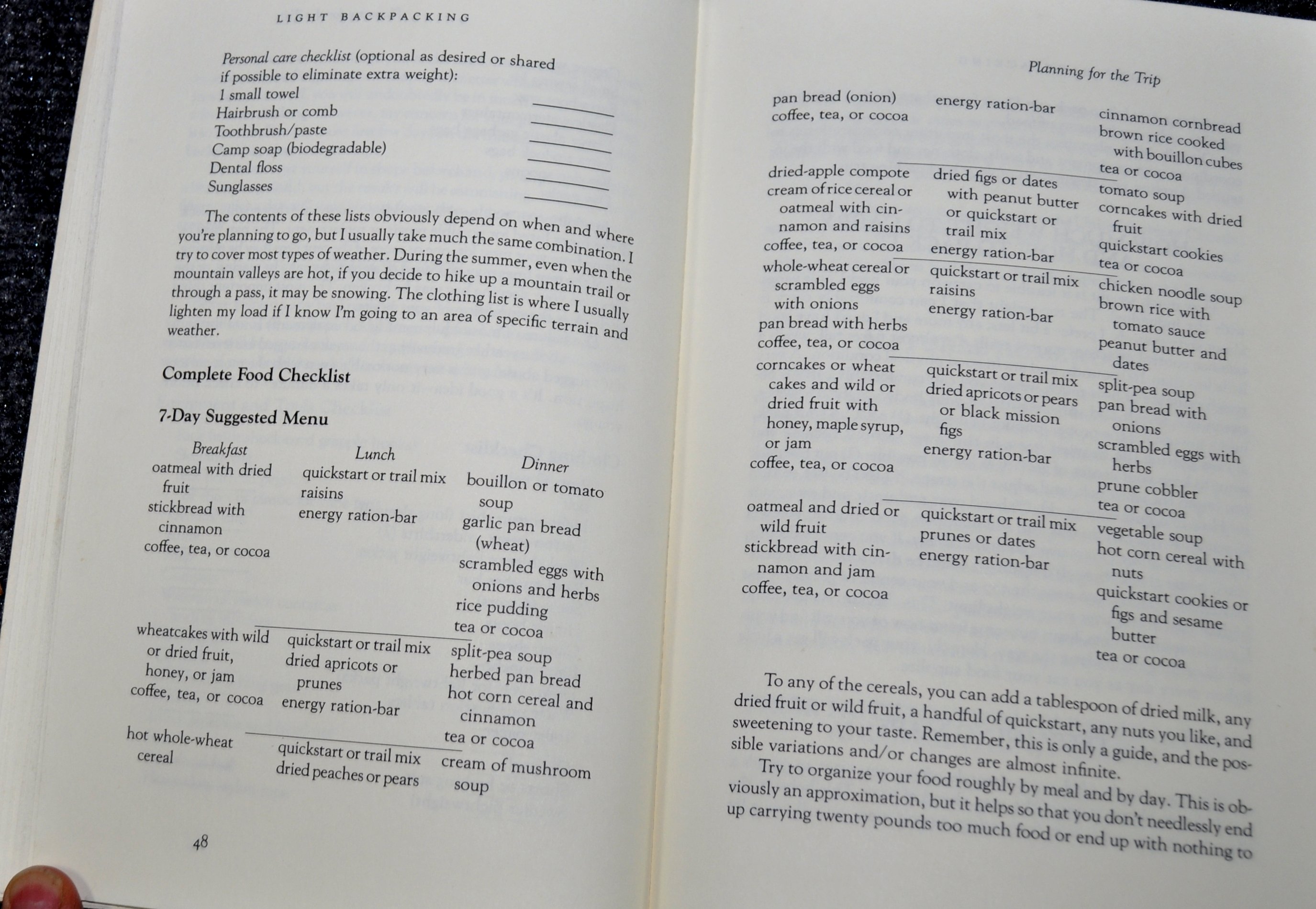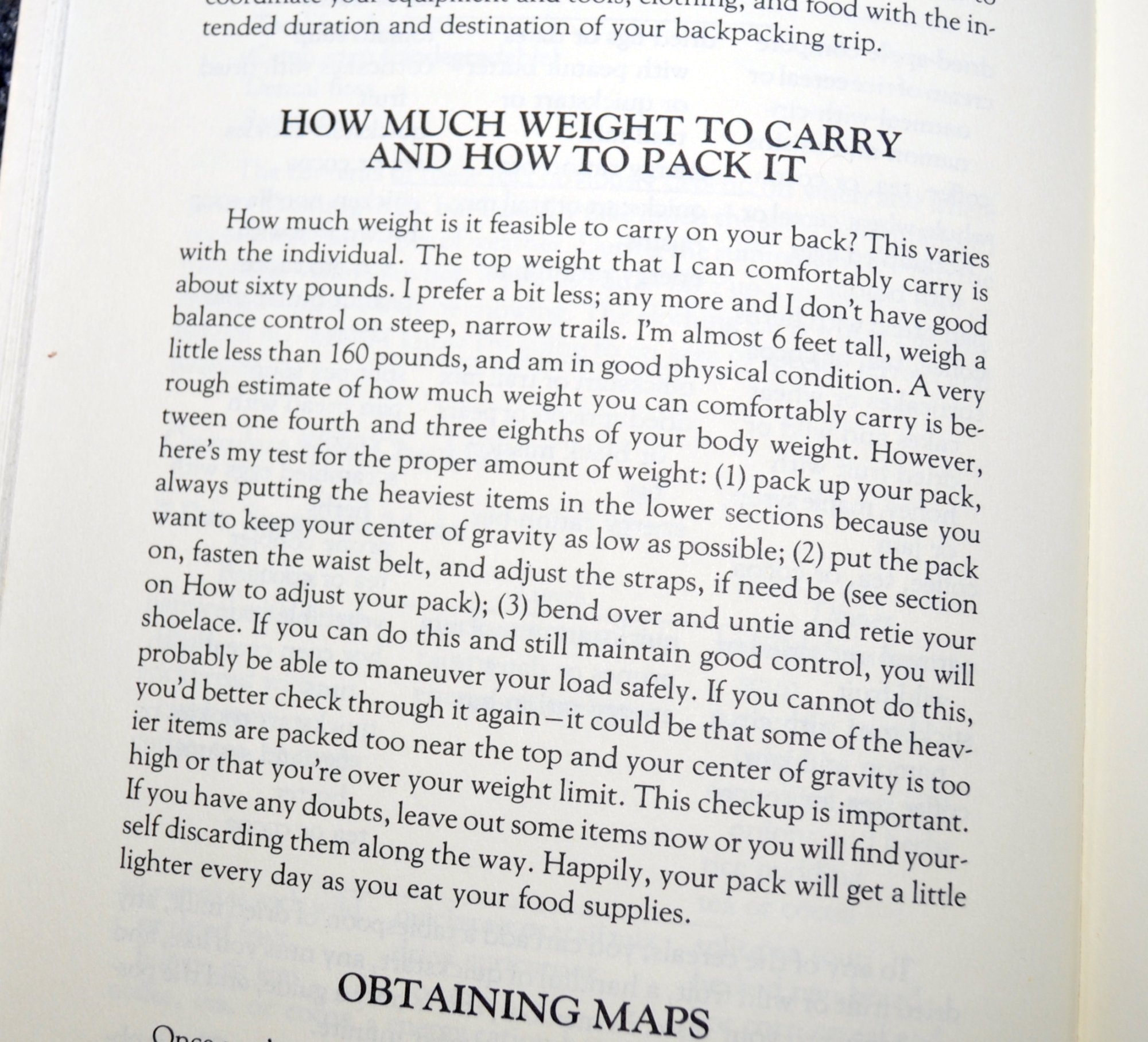Topic
Light Backpacking Book from 1981
Forum Posting
A Membership is required to post in the forums. Login or become a member to post in the member forums!
Home › Forums › General Forums › General Lightweight Backpacking Discussion › Light Backpacking Book from 1981
- This topic has 10 replies, 9 voices, and was last updated 6 years, 10 months ago by
 Tony Ronco.
Tony Ronco.
-
AuthorPosts
-
Jan 23, 2018 at 8:18 pm #3513960
I found this old paperback from 1981: ” Light Backpacking” by Donald J. Christian. It is interesting that the publisher’s note at the top reads “A WINCHESTER PRESS PACK-ALONG GUIDE” (at 8.6oz).



Still the old 1/4 body weight load limit. What was in the “Heavy Backpacking” book!
 Jan 23, 2018 at 8:36 pm #3513967
Jan 23, 2018 at 8:36 pm #3513967Wasn’t the 80s the heaviest time ever, with the advent of “bomber” gear? Before that everyone just took a tarp, a wool blankets and a tin cup, right?
Boot, bags and canteens….already lost me.
Jan 23, 2018 at 9:39 pm #3513982My first Scout overnight hike was in 1965 with a Trapper Nelson (designed by the Spanish Inquisition), a rectangular flannel lined sleeping bag, a Korean War era air mattress (that leaked), an Army Surplus mess kit and canteen and we slept in a waxed canvas pyramid tent. We “cooked” on a campfire and managed to keep from giving ourselves food poisoning. Of course I was wearing mostly cotton and Converse “hiking boots.” The trek was short but steep with 3000′ of miserable switchbacks. I thought I was gonna die.
I’ll never forget that the Eagle Scout had all the latest lightweight gear and brought in a steak on ice.
Jan 23, 2018 at 10:02 pm #3513993They’ve got the “put the heaviest items in the lower sections because you want your center of gravity to be as low as possible” fallacy.
First off, leave the heaviest items at home!
Then put the densest, necessary items nearest your back and high up, so you don’t have lean so far forward. You’re not more stable with a low CoG. You can stay stable more easily with a high CoG. Put a weight on one end of a pencil and try to balance it, upright, on your finger. You can do with the weight high, but not with the weight low.
Jan 24, 2018 at 1:06 am #3514031I’ll never forget that the Eagle Scout had all the latest lightweight gear and brought in a steak on ice.
I don’t know if my son will ever go back and make First Class, let alone Eagle, but I do know that now they don’t wait until Eagle to tell you to keep meat cold before you cook it.
Jan 31, 2018 at 11:28 pm #3515916In the 80s this was UL stuff.
I know I was there and unlike the 60s I remember it
30% of my body weight was at that time a lot less than I had been carrying, I weighed 80kg and I often had 45 kilo loads in winter, not at all unusual at the time and this was about the time nylon shells for sleeping bags started to become more affordable and tent weights started to drop. Of course I am talking winter; in summer you don’t need tents or sleeping bags here, just something to keep the insects off and a tarp
Heavy and low works for skiing, scrambling and climbing tho and a lot of good books from that time reflect the bias towards hard walking and scrambling as part of the normal pattern. Totally different to walking along a graded path
BTW a pencil weighted at the base is a lot more stable I just tried it
Feb 1, 2018 at 3:31 am #3515956My first trips were in the late 60’s. A Dacron fill bag that strapped on the outside of the pack. An open cell foam pad that was torso length. And an orange tube tent. Throw that into a cheapo external frame pack with a nylon bag, and we were ready to roll. And yes, my hiking boots were Converse All-Stars…
Feb 1, 2018 at 5:39 am #3515976Turns out there was an actual lightweight backpacking revolution in the early 1980s – that more or less sank without a trace:
https://rockssandwater.blogspot.com/2010/11/lightweight-backpacking-in-early-1980s.html
And I did the Boy Scout thing in the 1960s, including an aluminum-framed backpack with a canvas sack, unpadded shoulder straps, and no hip belt. Add the dacron sleeping bag (with built-in groundsheet!), leaky canvas pup tent, and an aluminum mess kit to cook canned Spam over an open fire. Hiking in a t-shirt, jeans, and Converse All-Stars with cotton socks.
I almost gave up backpacking.
— Rex
Feb 1, 2018 at 9:55 pm #3516047Ya know, as someone who actually remembers the ’70s and ’80s (I didn’t do much beyond Mary Jane – “believe me” – you could buy relatively light GERRY backpacks, small SVEA stoves, down bags and jackets, closed cell foam mattresses, aluminum pots and decent tarps (urethane coated but lighter than a tent).
So if you chose carefully you could have a 20 lb. base weight. “Notta too bad, notta too bad.” as FR. Guido Sarducci used to say on SNL.
AND, if you were a smarty pants you could buy a Frostline pack kit and substitute lighter fabrics in most places.
The tough part was finding light hiking boots (as hiking shoes were not yet “invented”). Vasque “Waffle Stompers” were pretty much it.
And forget aluminum hiking poles. that was a DIY project.
Feb 2, 2018 at 12:13 am #3516088Australia took a while to catch up mainly due to the ruggedness of our major walking areas. SW Tasmania is incredibly hard on gear as is a lot of New Zealand
When LW gear got here we adopted very quickly even if it did wear out quickly. We went LW and UL simply by making do with less but you cannot do that in winter so we winter snow campers still had to carry those heavy loads
Most of what I remember is being cold and wet a lot of the time, that doesn’t happen these days, I haven’t been wet & cold at the same time for decades.
This doesn’t mean we deliberately carried heavy packs, we trimmed and cut and always got our loads as light as possible, the mantra has always been “Count every ounce because every ounce counts” the weights were simply a consequence of the affordable materials available to us at the time. Times have changed and now the LW finely woven 3 ounce cottons are the expensive fabrics and 1 ounce ripstop is the cheap stuff
UL gear does have drawbacks where longevity us concerned tho and this can become a serious financial burden, my japara windshirt lasted 3 decades until it became unusable and I go trough a Montane UL windshirt every season because the fabric cannot be sewn strongly enough to withstand the treatment it gets CC skiing DIY seems to be the option there
Feb 18, 2018 at 11:36 pm #3519138RE: 80’s
If you followed Doug Robinson’s writings about his adventures (in the late ‘70’s) you would have a baseweight of 12 lbs. Then in July 1982 this issue of Backpacker came out. Fred Williams and Chuck Kennedy had baseweights of 5-1/2 lbs with a carry weight of 15 lbs for a 5 day trek of 92 miles. This issue really had a profound effect on my approach to backpacking.
https://docs.google.com/file/d/0B3QSQU2xVN0XekpkZEZVTTBSRjQ/edit?pli=1
-
AuthorPosts
- You must be logged in to reply to this topic.
Forum Posting
A Membership is required to post in the forums. Login or become a member to post in the member forums!
Our Community Posts are Moderated
Backpacking Light community posts are moderated and here to foster helpful and positive discussions about lightweight backpacking. Please be mindful of our values and boundaries and review our Community Guidelines prior to posting.
Get the Newsletter
Gear Research & Discovery Tools
- Browse our curated Gear Shop
- See the latest Gear Deals and Sales
- Our Recommendations
- Search for Gear on Sale with the Gear Finder
- Used Gear Swap
- Member Gear Reviews and BPL Gear Review Articles
- Browse by Gear Type or Brand.






